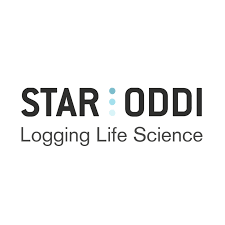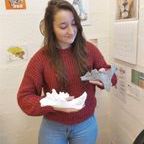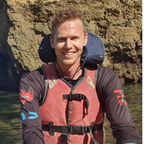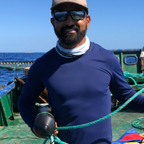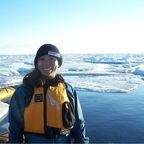Animal
The Session information is still subject to change.
A1 - Multiscale Musculoskeletal Mechanics and Modelling
Session Description
Muscle is a hierarchical tissue that traditionally has been studied in “silos” focused at single scales of biological organization, but is better approach with 21st century convergence science. Convergence science takes multiscale approaches, both to understand function, and to uncover emergent properties of biological systems. To this end, researchers have recently assembled teams with diverse sets of expertise, ranging across -omics, molecular and myoprotein interactions, tissue architecture, neuromechanics, skeletal kinematics, and organismal movement performance, in order to discover the multiscale underpinnings of how muscle engenders movement. It is time for these groups to meet and exchange and communicate discoveries to each other and the broader research community.
A2 - Experimental Palaeobiology - Bringing Fossils "Back to Life"
Session Description
This session will cover a variety of studies which, in their broadest sense, aim to draw conclusions on functional morphology, biomechanics, and physiology in extinct organisms. Contributions often use data gathered from modern species to provide interpretations on the biology of organisms in the fossil record. This will include, but will not be limited to: anatomical descriptions and comparative dissections; comparative physiology; sensory mechanics; hard-tissue microstructural analyses; kinematics; multi-body dynamics; computational fluid dynamics; etc. Topics are intended to range across the mechanical and physiological spectrum, incorporating aspects of feeding, locomotion, sensory perception, physiology, etc. among vertebrates, invertebrates, plants, and microorganisms.
 A3 - Functional Morphology of Locomotion and Feeding: A Tribute to Peter Aerts
A3 - Functional Morphology of Locomotion and Feeding: A Tribute to Peter Aerts
Session Description
Uncovering the relationship between morphology and function is essential to understanding how animals, in all their diversity, cope with the physical limitations and opportunities of important life functions. This goal encompasses the long-standing research field of functional morphology. Obtaining a detailed functional morphological understanding is challenging because it often requires combining cleverly designed experiments with mathematical modelling approaches in a comparative framework. The research career of Prof. Peter Aerts is packed with examples of how such integration between experiments and modelling can succeed to answer open questions on the functional morphology and neuromechanics of locomotion and feeding. This session honours Peter Aerts' contributions in this field by bringing together cutting-edge research in the spirit of his major accomplishments.
A4 - Kinematics and Robotics - state of the arts kinematics and their transfer to robotics
Session Description
Kinematic analyses have been a fundamental part of biomechanics research. Using video material and landmarks on animal (and human) morphology, their positioning over time can be recorded and analyzed leading to insights of their respective capabilities in terms of e.g. gaits, speed, maneuverability and the respective underlying morphological features. With rapid technological development in video recording, image analysis and its automation as well as machine learning, not only do kinematic analyses increase in spatial and temporal accuracy, but are now manageable in 3D. With todays high resolution 3D kinematics, animal movements can be analyzed in higher complexity and what is more, such data also becomes more and more transferable onto robotic prototypes. Such robotic prototypes not only promise to improve robotic through designs optimized by nature but can help biomechanics studies to test hypotheses on adjustable models i.e. robot prototypes. This session aims to showcase the state of the arts in kinematics and welcomes all kinematic studies but especially those that try to transfer the gained knowledge to robotic or other prototypes.
A4 (2) - Innovative Methods and Techniques in Biomechanics
Session Description
The session aims to showcase cutting-edge advancements in hardware and software development for research in biomechanics. We invite talks and posters to present their latest pioneering techniques for data collection and analysis, welcoming a wide range of approaches from high-tech innovations to cost-effective solutions, to the biomechanics community.
Building on the presentations from the session we organised at SEB Conference Prague 2024, we encourage submissions across various topics in the field of biomechanics. These may include data-driven methods such as machine learning and AI tools, robotics and automation in kinematic studies; novel sensors and measurement techniques. We're also keen to see advanced imaging and quantification methods, as well as innovative software solutions for data management and analysis. We especially appreciate presentations demonstrating cost-effective and accessible solutions, time-efficient approaches to biomechanical studies, interdisciplinary collaborations, novel applications of existing technologies, and "life-hack" style innovations that challenge conventional methods and allow for wider participation. These could range from sophisticated AI applications to seemingly basic yet revolutionary techniques that address common challenges in new ways.
Researchers at all career stages, from students to established professionals, are encouraged to participate. This year's SEB featured presentations from undergraduate students, PhD candidates, postdoctoral researchers, and senior scientists, reflecting the need of the entire biomechanics community to discuss the more technical details of the field. We hope the discussion will inspire new collaborations that can drive the development of new powerful and accessible tools in biomechanics.
A5 - Open Biomechanics
Session Description
Biologists are concerned with life, and engineers study technology. Biomechanics is where both meet, as it is the study of the technology of living things - as biomechanists, we study the mechanical principles and function of biological systems, at any organisational level - including the molecular, cellular, meso- and organismal scale - and across all kingdoms - plants, animals, fungi, bacteria and what have you. This breadth is reflected in our name: we are open to and excited about contributions from colleagues that stem from a wide range of disciplines, including zoologists, botanists, molecular biologists, physiologists, kinesiologists, mathematicians, engineers, biomimeticists, computer scientists, chemists and much more.
At the SEB Annual Conference, we host Biomechanics presentations in podium and poster sessions, which cover a broad range of general biomechanical topics, including animal locomotion, feeding, functional morphology, muscle-tendon mechanics, biological materials, evolutionary biomechanics, biorobotics, etc. We also run special sessions, contributed and organised by members of our vibrant, broad and inclusive community. We are friendly, and we are welcoming - come and join us!
A6 - Comparative Endocrinology
Session Description
 A7 - Stress as a Driver of Neural Plasticity: From Brains to Behaviour
A7 - Stress as a Driver of Neural Plasticity: From Brains to Behaviour
Session Description
Exposure to stressors can have a variety of effects on animals, from activating acute neuroendocrine stress responses that help the animal cope with the stressor, to inducing longer-term changes in their physiology and behaviour. This session will focus on stress as a driver of brain plasticity, from developmental programming to neural plasticity in adults. Fishes are particularly useful study organisms for these questions because of their substantially higher potential for adult neurogenesis than other vertebrates. From dissecting the molecular mechanisms through which stress alters neurogenesis and neuron development to evaluating the impacts of stress on the behaviour of individuals within and across generations, this session will consider all aspects of stress as a modulator of brain and behaviour.
 A8 - Animal Responses to a Changing World: What About Cognition?
A8 - Animal Responses to a Changing World: What About Cognition?
Session Description
Cognition refers to the processes involved in acquiring, processing, and utilizing information from the environment, such as perception, learning, memory, decision-making, and problem solving, which guide behavioral decisions, essential for the survival of animals. In the context of anthropogenic changes, animals must navigate novel environmental cues and adjust their behaviors to cope with altered conditions, such as habitat modification and resource depletion. However, environmental stressors might impair their cognitive abilities and threaten their survival. At the population level, a decline in cognitive performance might drastically reduce the adaptive potential of species in response to environmental changes, highlighting the need for a broader understanding of how environmental factors influence cognition and how these changes might impact larger ecological scales. This session will emphasize the importance of incorporating cognitive perspectives into studies investigating the response of non-human animals (any taxa, whether aquatic or terrestrial) to a wide range of environmental stressors. We will organize a discussion after the session to synthesize the current state of knowledge in the field of animal cognition and establish future directions, particularly regarding (1) the potential for insights from animal cognition to inform conservation strategies, and (2) solutions to address the current methodological limitations of the discipline.
A9 - Going Beyond Death: Understanding Ecologically and Physiologically Relevant Impacts of Environmental Toxicants
Session Description
The environment is under increasing strain from human-derived impacts including chemical contamination and climate change. To understand the effect of these contaminants, toxicologists use the endpoint of death (i.e., LC50-median lethal concentration to cause death) to determine sensitivity under controlled static conditions. While a crude metric, it is so far the most indicative of impact within the environment and universal across all species. However, what is needed is a way to contextualize effects that are sub-lethal so that we can find another indicator that does not result in death across species and ecosystems. Death may be a straightforward way to understand environmental contamination but is there a key physiological mechanism that could indicate general impacts of contaminants within a contaminant class? Less restrictive behavioural and physiological endpoints could be used to better indicate ecosystem health before population collapses. In this session, we will present an exploration of research that strives to understand the true ecological and physiological impact of pollutants in the environment by studying changes to behaviour, physiology, and/or whole ecosystem function in the context of a rapidly changing environment.
A9 (2) - Innovating for a Sustainable Future: Mitigating the Environmental Risks of High-Tech Solutions
Session Description
This session explores how cutting-edge technologies while advancing human capabilities, pose significant challenges in an evolving global landscape. High-tech innovations address environmental issues, creating environmental risks. Though solving many global challenges, technologies such as electric vehicles, contribute to environmental degradation through energy consumption, resource depletion, and e-waste. Participants will discuss the responsibility of tech leaders and policymakers in balancing innovation with sustainability, examining how green tech, renewable energy, recycling processes and sustainable methods can mitigate these risks. The session emphasizes the need for foresight and responsible innovation to ensure that technological progress aligns with environmental sustainability. Investigation regarding environmental impacts on aquatic and terrestrial environments is welcome.
A9 (3) - Pollution, Osmoregulation and Energy Use
Session Description
Pollution as an evolutionary driver is now recognised by several recent studies. It is still necessary to identify the physiological effects of anthropogenic pollution on key physiological processes that can modify local populations and induce molecular and phenotypic changes.
A10 - Riding The Wave: Insights Into Plastic and Evolutionary Animal Responses to Temperature Challenges
Session Description
Climate change is causing increased and variable thermal conditions in natural ecosystems and organisms must deal with these changing thermal conditions for survival. Climate induced thermal stress affects both endothermic and exothermic organisms across all biomes. Organisms can modify their behavioural, physiological, and morphological phenotypes via plastic responses to thermal conditions as well as the evolution of novel phenotypes. These changes potentially occur due to changes in gene expression, epigenetic state, physiological or cellular processes. To better understand how organisms respond to novel thermal conditions an interdisciplinary approach is needed. By linking natural systems where species have evolved adaptations to extreme thermal conditions to individual level variation that may facilitate adaptation to novel thermal environments in the near future, we can better understand the potential for organisms to deal with the increasing challenge posed by climate change. The aim of this session is to bring together researchers from evolutionary, physiological, and ecological backgrounds to better understand the capacity for organisms to adapt to new and changing thermal environments. Ultimately, by highlighting interdisciplinary research on how organisms have successfully adapted to extreme thermal environments and the capacity for species to adapt in the present, we may be able to predict future responses to climate induced thermal conditions.
A11 - Open Water: The Biology of Pelagic Fishes
Session Description
Pelagic fish inhabit vast and dynamic open waters, requiring specialized physiological and behavioural adaptations. Their unique traits make them especially challenging to study in laboratory settings, and they are highly vulnerable to overfishing, pollution, and climate change. This session aims to explore all facets of pelagic fish biology and highlight how recent advances in telemetry, biologging, environmental DNA, and controlled experiments can enhance our understanding and support their sustainable management. Physiological adaptations such as thermoregulation, large-scale migrations, social behaviour and prey-predator dynamics, as well as interactions with environmental factors, are all topics of interest in this session.
A12 - Biotic Interactions And Ecosystem Responses Under Anthropogenic Environmental Change
Session Description
Human-induced changes in global physical and chemical processes are threatening all types of ecosystems. While the direct impact of these stressors on organisms is well characterized, we still have a limited understanding of how these stressors influence biotic interactions, which form the basis for numerous ecosystem properties and processes. We welcome submissions investigating the effects of typical global change stressors (e.g. warming, eutrophication, salinization, etc.), as well as less studied stressors (e.g. artificial light at night, plastic pollution, etc.). The biotic interactions examined can include both inter- and intra-specific interactions, including competition, predation, herbivory, mutualism, commensalism, parasitism, etc. Studied endpoints can range from demographic traits such as abundance and population growth rates to individual traits such as feeding rate, functional responses, antipredator behaviour, etc. We further invite submissions, empirical or theoretical, that translate the effects of anthropogenic stressors on species interactions into impacts on populations, communities, and ecosystems, and explore these questions within an eco-evolutionary framework.
A13 - The Environmental Causes and Consequences For Offspring of Parental Effects
Session Description


A14 - Vulnerability And Adaptations Of Early Life Stages To Environmental Stressors
Session Description
Anthropogenically induced environmental changes are exposing organisms to novel and intensified stressors. Early life stages are particularly vulnerable to prevailing environmental conditions since phenotypic traits are still being formed. While some effects can be neutral, many responses may also have positive or negative fitness consequences, leading to potentially profound and long-lasting impacts at both the individual and population level. This session will focus on experimental approaches in the lab or field that explore the responses of early life stages to environmental stressors, the impacts that these may have on individuals and populations, and how early life stress influences the development of the adult phenotype. We invite contributions on a range of taxa and stressors, including temperature, acidification, hypoxia, toxicants, pathogens, food availability, social circumstances and perceived danger, stressors experienced directly and indirectly in early life, and outcomes measured at different biological levels. We are particularly interested in highlighting mechanistic processes of homeostasis that have not been well studied in this context, such as inflammation and immune function, cellular and whole organism aerobic metabolism, alongside more studied areas such as neuroendocrine regulation, and morpho-physiological changes with functional implications in organismal performance. We seek to link such processes with potential fitness consequences, as well as the role of parental care and other resilience factors in buffering stress exposure. Finally, we aim to highlight how early-life stress exposure can disrupt phenotype-environment matching, a prevalent concern in the face of ongoing global change.
This session is sponsored by Loligo systems and Pyroscience


 A16 - Insights and Tools From Biologging For Conservation Physiology
A16 - Insights and Tools From Biologging For Conservation Physiology
Session Description
The topic will cover research undertaken using biologging approaches in freshwater, marine and terrestrial ecosystems, aimed at providing insights on animal physiology for conservation and management. It also will feature new technological developments in biologging technology.
This session is sponsored by Star Oddi
